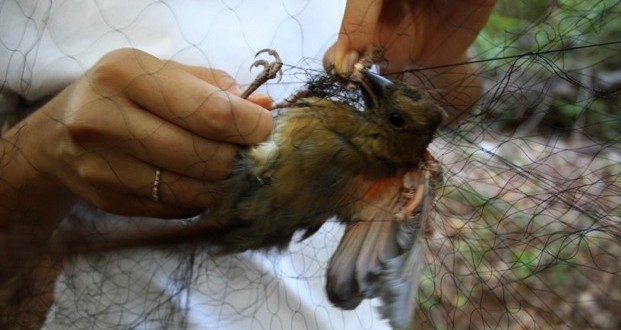For decades, it’s been the stuff of birding legend: Each fall, fist-sized songbirds called blackpoll warblers leave the spruce forests of New England and eastern Canada and fly south across the open ocean toward South America.
Now, improbable though it seems, the rumors have been proven true. A research team led by an ecologist at the University of Massachusetts Amherst outfitted five birds with tiny geolocator backpacks and found that each completed the incredible journey, flying up to 1,721 miles in one go.
“This is the first study to provide direct evidence of the birds’ migration route – we found they flew directly over the Atlantic Ocean to reach their wintering grounds in South America,” said Ryan Norris, a professor in Guelph’s Department of Integrative Biology, who led the Canadian portion of the research.
It also involved researchers at Acadia University, Bird Studies Canada, the University of Massachusetts, the Vermont Centre for Ecostudies and the Smithsonian Conservation Biology Institute.
Blackpolls are songbirds weighing about 12 grams, or less than two Canadian loonies. They are found in boreal forests of Canada and the United States from spring until early fall. Before migrating to South America for the winter, they spend summers in boreal forests stretching across North America.
“The indirect evidence in favour of an Atlantic voyage was fairly strong,” Norris said.
“You have birds landing on ships in the Atlantic, radar studies off the tip of Nova Scotia showing the birds heading south, and very few sightings of blackpolls in the southern U.S. in the fall.”
The researchers used geo-locators to track blackpolls on their annual flight south to the Caribbean and on their way north to Canada and the United States in the spring.
The tiny devices — each weighing only 0.5 g — sat on the backs of the birds and were attached using leg loop harnesses, much like a person would wear a backpack.
They were attached to birds in Nova Scotia and Vermont in the summer. The researchers also placed coloured plastic bands on the birds to identify them when they returned.
The geo-locators tracked the birds’ flight path, but, because of their small size, they were not able to transmit the data remotely.
“We waited for them to return in the spring and then searched the forest to find the blackpolls with geo-locators,” said William DeLuca, a research fellow at U Massachusetts, who led the Vermont part of the study.
The team retrieved the devices from those birds to look at the data.
“When we accessed the locators, we saw the blackpolls’ journey was indeed directly over the Atlantic. The distances travelled ranged from 2,270 to 2,770 km,” said DeLuca.
Each bird took 2 ½ to three days to make the trip. To prepare for the flight, they build up their fat stores, said Norris.
“These birds have a tremendous voyage ahead of them, with some likely flying from western Canada to the east coast before flying south. They eat as much as possible, in some cases doubling their body mass in fat so they can fly without needing food or water,” he said.
“For blackpolls, they don’t have the option of failing or coming up a bit short. It’s a fly-or-die journey that requires so much energy.”
Canadajournal/Press Releases
 Canada Journal – News of the World Articles and videos to bring you the biggest Canadian news stories from across the country every day
Canada Journal – News of the World Articles and videos to bring you the biggest Canadian news stories from across the country every day



